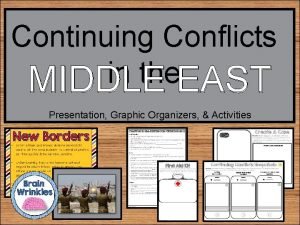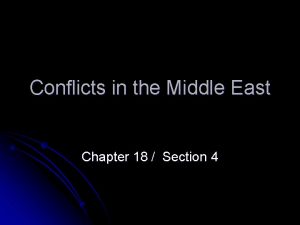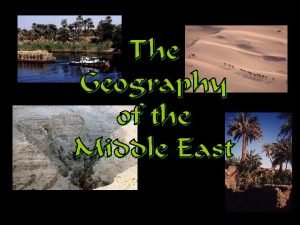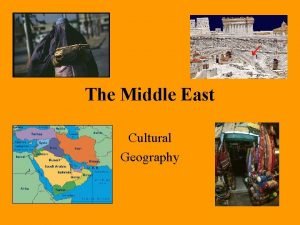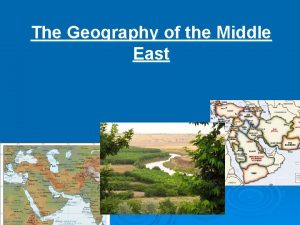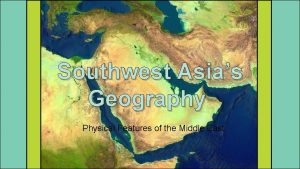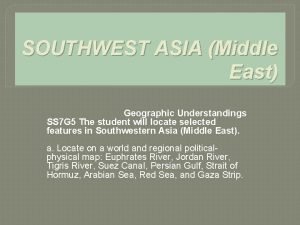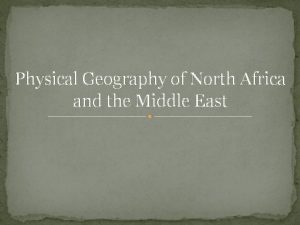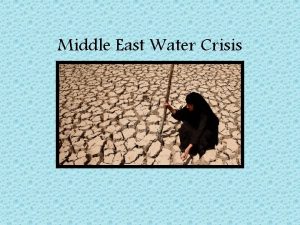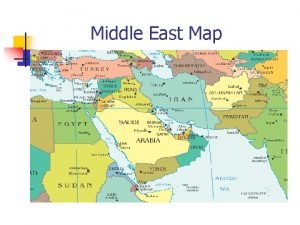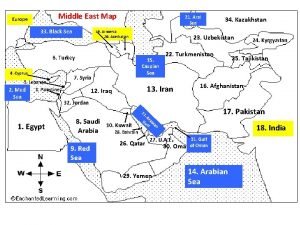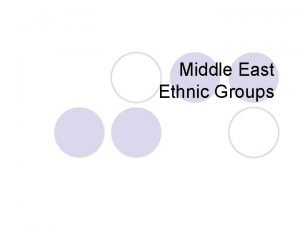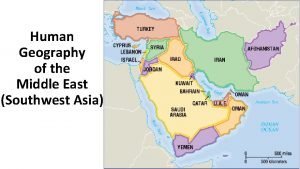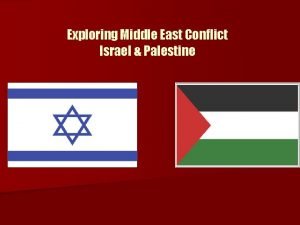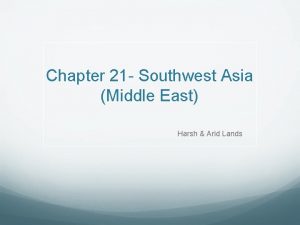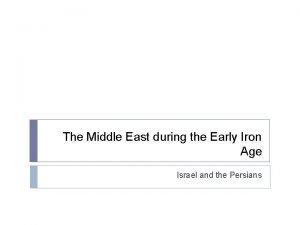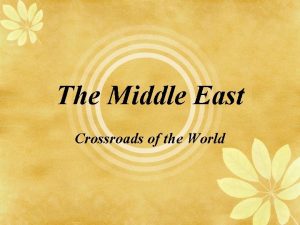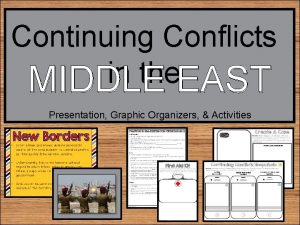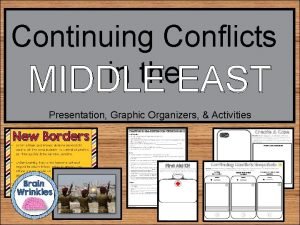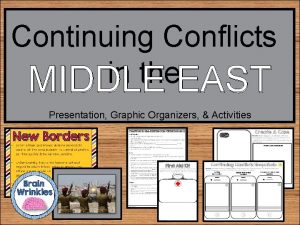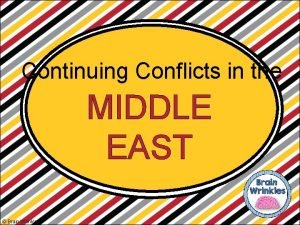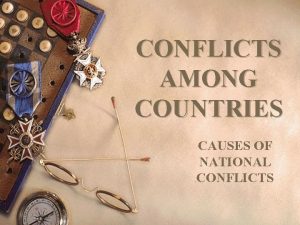Continuing Conflicts in the MIDDLE EAST Presentation Graphic

























- Slides: 25

Continuing Conflicts in the MIDDLE EAST Presentation, Graphic Organizers, & Activities

Continuing Conflicts in the MIDDLE EAST © Brain Wrinkles

Ottoman Empire • The Ottoman Turks were known for their ruthless pursuit of land. • At its height, the Ottoman Empire was six times the size of Texas. • Its lands stretched from what is now Turkey and parts of southeastern Europe, northern Africa, and southwestern Asia.

© Brain Wrinkles

Collapse • Over time, the Ottoman sultans were not very capable of ruling and the empire began to decline. • During World War I, the Ottoman Empire sided with the Central Powers, who ended up losing the war. • Afterwards, the government collapsed and the land of the former Ottoman Empire was divided among the victorious European countries. • The League of Nations gave France and Great Britain control of partitioning the Ottoman

Partitioning • After partitioning, France took control of Syria, Lebanon, Algeria, Morocco, and Tunisia. • The British were in charge of Egypt, Iraq, Palestine, Jordan, and a chunk of Saudi Arabia. • Great Britain heavily influenced the governments that were put in place in the territories it controlled, and for years, these countries remained under British supervision. • The problems created by this land division have persisted in the Middle East today.

© Brain Wrinkles

New Borders • Great Britain and France desired immediate control of the area in order to control oil profits, so they quickly drew up new borders. • Unfortunately, they drew borders without regard to which tribes, religious groups, and ethnic groups would be forced under one government. • Arab countries were not consulted about the division of the territory.

Land Disputes • As they divided the land, they drew borders that paid no attention to local cultures. • This caused some ethnic and religious groups to be separated by boundaries, while other rival groups were grouped together. • Claims over land led to long periods of conflict and bloodshed in the region. • For example, from 1980 to 1988, Iran and Iraq fought a war over disputed oil-rich territory.

Iraqi soldiers pose in front of a bulletriddled mural of the Iranian leader. © Brain Wrinkles

Kurds • Another problem created by the land division has impacted the Kurds, an ethnic group that have lived in the region for centuries. • Despite their large population, Kurds did not get their own territory when Europeans partitioned the Middle East. • The Kurds were divided between Turkey, Iran, Syria, and Iraq. • These countries are uneasy with the vibrant ethnic group and attempt to rule them with an iron fist.

Distribution of Kurdish People in Turkey, Iraq, Iran, and Syria © Brain Wrinkles

Kurds • The Kurds were not given their own homeland, which has left the Kurdish people vulnerable to extreme persecution. • Throughout the last decades of the 20 th century, Iraq’s former dictator Saddam Hussein attempted to eliminate his country’s Kurdish population. • Today, Kurds are suffering greatly from

Kurdish Refugees from Syria © Brain Wrinkles

Religion • Disputes over religion also lie at the heart of the continuing conflict in the region. • Some of the conflicts started when Europeans took control of the region, while others date back long before Europeans came. • The hostility between Arabs and Jews, and among different Islamic factions, forms the basis of the region’s modern

Palestine & Israel • In 1948, the United Nations partitioned Palestine into the Jewish nation of Israel and the Arab Muslim state of Palestine. • Palestinians refused to recognize Israel as a nation and as soon as it was established, fighting broke out. • Palestine, with help from the neighboring Arab countries of Lebanon, Syria, Jordan, Egypt, and Iraq, engaged in conflict with Israel that has lasted for decades.

© Brain Wrinkles

© Brain Wrinkles

Palestine & Israel • Arab nations do not recognize Israel as a nation, and Jewish Israel lives in virtual isolation from its neighbors. • There is constant conflict between Palestinians and Israelis living in the area called the Gaza Strip. • The land in Israel is sacred to both Jews and Muslims, so the two groups are constantly fighting over it.

© Brain Wrinkles

Gaza Airstrikes © Brain Wrinkles

Shia & Sunni • Many conflicts also occur within the Muslim sects in Southwest Asia. • As a result of European partitioning after WWI, Sunni and Shia Muslims, who were often rivals, were now forced to get along together in one country (Iraq). • The two religious groups have fought for power in Iraq for decades. • The more aggressive Iraqi Sunnis have also clashed with the Iranian Shiites.

© Brain Wrinkles

© Brain Wrinkles

Shia & Sunni • In 1979, fundamentalist Muslims overtook Iran’s government and imposed a strict interpretation of Islamic law on all of the country’s citizens. • Since then, they have worked hard to remove all influences of western society.
 Conflicts in the middle east comprehension check
Conflicts in the middle east comprehension check Chapter 18 section 4 conflicts in the middle east
Chapter 18 section 4 conflicts in the middle east North american
North american Winds that blow over short distances are called
Winds that blow over short distances are called East is east and west is west
East is east and west is west Graphic weight meaning
Graphic weight meaning Ghost graphic story graphic and wayfinding
Ghost graphic story graphic and wayfinding Map of the middle east with latitude and longitude lines
Map of the middle east with latitude and longitude lines Ethnic groups in the middle east
Ethnic groups in the middle east Why is it called middle east
Why is it called middle east Inlet of indian ocean between africa and asia
Inlet of indian ocean between africa and asia Jordan river on map
Jordan river on map Physical features of the middle east map
Physical features of the middle east map Gope
Gope Middle east map
Middle east map Black sea on middle east map
Black sea on middle east map Ethnic groups in the middle east
Ethnic groups in the middle east Human geography of middle east
Human geography of middle east Israel and palestine
Israel and palestine Gosforth east middle school
Gosforth east middle school Why is the middle east so dry
Why is the middle east so dry Bio time 7.0 download
Bio time 7.0 download Where is ukraine located
Where is ukraine located Middle east before islam
Middle east before islam Iron age middle east
Iron age middle east Crossroads of the world middle east
Crossroads of the world middle east
